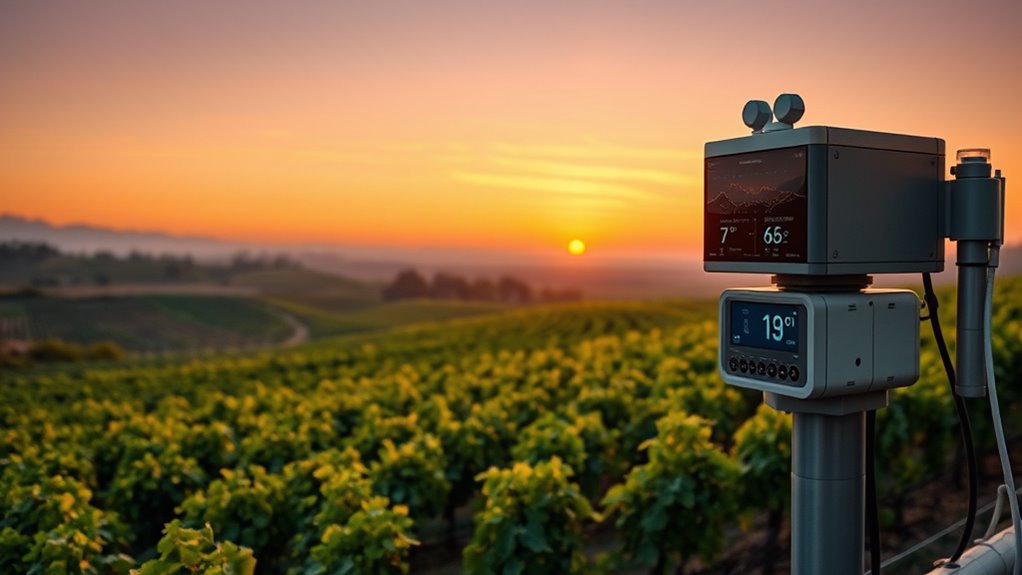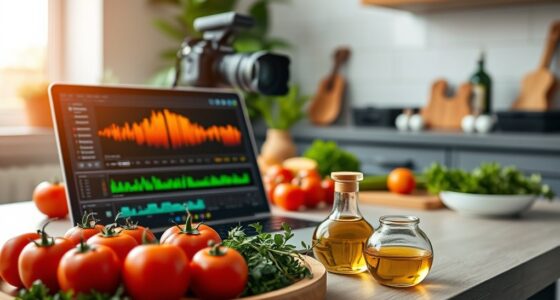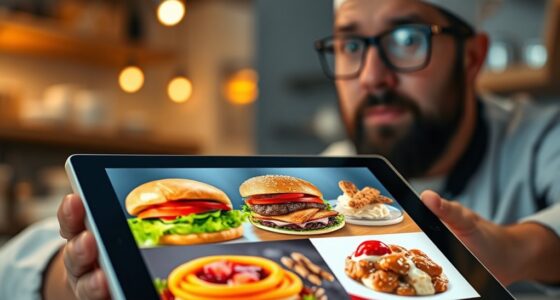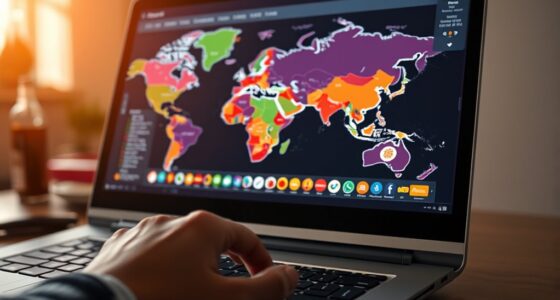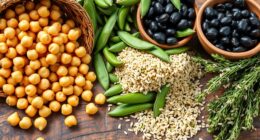Using AI to predict wine harvest quality based on weather patterns allows you to analyze vast amounts of climate data in real-time. AI models identify subtle trends affecting grape ripening, health, and flavor development, helping you make proactive adjustments in vineyard practices. This approach enhances your ability to forecast quality and optimize harvest timing despite climate variability. Stay with us to discover how this technology can transform your vineyard management and boost your wine’s consistency.
Key Takeaways
- AI analyzes historical and real-time weather data to forecast grape ripening conditions affecting harvest quality.
- Machine learning models identify subtle weather trends that influence grape health and flavor development.
- Predictive analytics optimize harvest timing and vineyard practices to enhance wine quality amid climate variability.
- AI-driven simulations assess future climate scenarios to select suitable grape varieties and adapt management strategies.
- Real-time weather monitoring enables proactive interventions, reducing risks of weather-related crop damage and ensuring consistent quality.
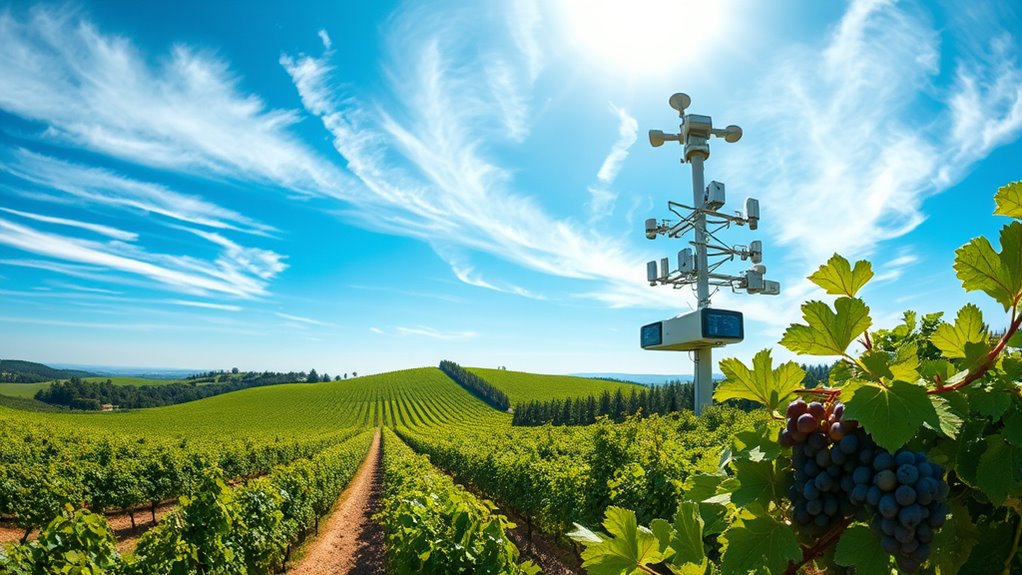
Predicting the quality of a wine harvest has traditionally relied on experience and seasonal observations, but now, artificial intelligence is changing that. By analyzing vast amounts of weather data, AI tools can forecast harvest outcomes with a level of accuracy that surpasses conventional methods. This shift is especially vital as climate change introduces greater variability in weather patterns, making traditional predictions less reliable. You no longer have to depend solely on gut instinct or historical trends; instead, you can leverage AI-driven models to inform vineyard management decisions more precisely.
Climate change impacts vineyard management profoundly. As temperatures fluctuate unpredictably and weather events become more extreme, grape growers face new challenges in maintaining consistent quality. AI can help you navigate this uncertainty by identifying subtle weather trends that influence grape ripening, sugar levels, acidity, and overall grape health. With real-time weather data integrated into AI systems, you gain insights into how changing conditions might affect your yield and quality, enabling you to adjust practices proactively. For example, if an AI model detects an early heatwave or drought, you can modify irrigation schedules, canopy management, or harvest timing to mitigate adverse effects.
Furthermore, AI enhances vineyard management by providing tailored recommendations based on predictive analytics. Instead of relying on generic schedules, you can optimize watering, pruning, and pest control strategies in response to specific weather forecasts. This precision allows you to improve grape quality while conserving resources. As climate change accelerates, these adaptive strategies become essential for maintaining consistent harvests year after year. You’ll be better equipped to plan ahead, reduce losses, and ensure that your vineyard remains resilient amid volatile weather patterns.
In addition, AI-powered tools can analyze long-term climate data to identify trends and help you develop sustainable practices. For instance, if certain temperature ranges or rainfall patterns are becoming more prevalent, you can select grape varieties better suited to future conditions. This forward-looking approach is vital for vineyard management in a changing climate, supporting both productivity and sustainability. With AI, you’re not just reacting to weather changes—you’re anticipating them, making smarter decisions that safeguard your vineyard’s future.
Frequently Asked Questions
How Accurate Are AI Predictions for Wine Harvest Quality?
AI predictions for wine harvest quality can be quite accurate, but they’re influenced by climate variability and AI model limitations. You’ll find that models improve as they analyze more data, but unexpected weather changes can still impact results. While AI offers valuable insights, it’s essential to remember that predictions aren’t foolproof. You should combine AI forecasts with expert judgment to better manage harvest expectations despite climate variability.
Can AI Forecast Long-Term Weather Impacts on Vineyards?
Did you know climate variability can influence vineyards for decades? AI can forecast long-term weather impacts on vineyards by analyzing historical climate data and trends. This helps you anticipate challenges, adapt vineyard management strategies, and optimize grape quality. While predictions aren’t perfect, AI provides valuable insights, enabling you to plan ahead and mitigate risks caused by changing weather patterns over time.
What Data Sources Are Used to Train the AI Models?
You use weather data and satellite imagery to train AI models for predicting wine harvest quality. Weather data provides detailed information on temperature, rainfall, and humidity, while satellite imagery offers visual insights into vineyard health and growth patterns. Combining these sources helps the AI learn how environmental factors influence grape development, enabling more accurate harvest predictions. This integrated approach improves your ability to anticipate harvest outcomes based on weather and landscape conditions.
How Does AI Handle Unexpected Weather Events?
When unexpected weather events like sudden frost or heatwaves occur, AI adapts by analyzing recent climate variability and weather anomalies. For instance, in a hypothetical vineyard, AI models incorporate real-time sensor data to adjust predictions, helping growers respond promptly. This flexibility allows AI to handle unpredictable weather, providing more accurate harvest quality forecasts despite the chaos of climate variability and weather anomalies.
Are There Ethical Concerns in Using AI for Wine Production?
You should consider the wine industry ethics and AI decision transparency when using AI in wine production. While AI helps optimize quality, it raises concerns about fairness, data privacy, and accountability. You need to guarantee transparency in AI decisions so that growers and consumers understand how data influences outcomes. Addressing these ethical issues helps maintain trust and promotes responsible AI use in the wine industry.
Conclusion
By harnessing AI to analyze weather patterns, you can stay ahead of the game and make more informed decisions for your wine harvest. This technology helps you spot potential issues early, giving you a leg up in producing top-quality wine. Remember, knowledge is power—don’t let this opportunity slip through your fingers. With AI on your side, you’ll be better equipped to turn weather challenges into a smooth harvest, proving that sometimes, the early bird catches the worm.
